The handsome, sweet-tempered Ball Python is one of the most favored and adored pet snakes!
The Ball Python Python regius is a very popular constrictor and perhaps the most popular pet snake. This is due to its small size, reasonable price, and docile nature. It is the smallest of the African python species. When disturbed, rather than displaying aggression it has a tendency to curl up in a tight ball as a defensive behavior. Thus it is commonly known as the Ball Python in the United States, though in Europe it is referred to as the Royal Python.
These are not as large as many of the other constricting snakes that are kept as pets. The Ball Python will typically reach 3 to 4 feet (.91 – 1.2 m) in length, although there are occasionally specimens that reach 5 feet (1.5 m). They have an attractive natural coloring, a dark brown background with broken irregular cream or yellowish patches. There are also many unusual color and pattern variations that occur naturally. This has inspired the breeding efforts of enthusiasts to develop these color morphs, with one of the most exiting and popular being the Albino Ball Python.
Ball Pythons have a passive nature. They are curious and gentle snakes that can make a good pet snake for the beginner. They are slow moving and rarely bite. Their temperament and willingness to be handled makes them easier for a child to hold, though you should always supervise children when they are handling them. They will typically live 20 to 30 years in captivity or longer. with one specimen reported to have lived for up to 48 years.
These snakes are commonly sold in pet stores and online. There are many captive bred specimens becoming more readily available, but many Ball Pythins are wild caught imports from the wilds of Africa. As they grow and are handled, they will become more tame and make wonderful pet reptiles.
There can be some challenges with these snakes, including heath problems when you first obtain one, and then some snakes will refuse to eat for prolonged periods of time. Common ailments they are susceptible to tending to affect imported snakes more so than captive bred. When choosing a snake look for one that is alert, has a well rounded body, and clean eyes and vent. Check for signs of respiratory problems, indicated by wheezing or bubbles around the nostrils. Also check for things like ticks and mites, mouth rot, and blister disease.
- For more information on keeping Snakes see: Pet Snakes: Choosing a Snake and Snake Care for All Types of Snakes
Ball Python Care
Scientific Classification
| Kingdom: | Animalia |
| Phylum: | Chordata |
| Class: | Reptilia |
| Order: | Squamata |
| Family: | Boidae |
| Genus: | Python |
| Species: | regius |
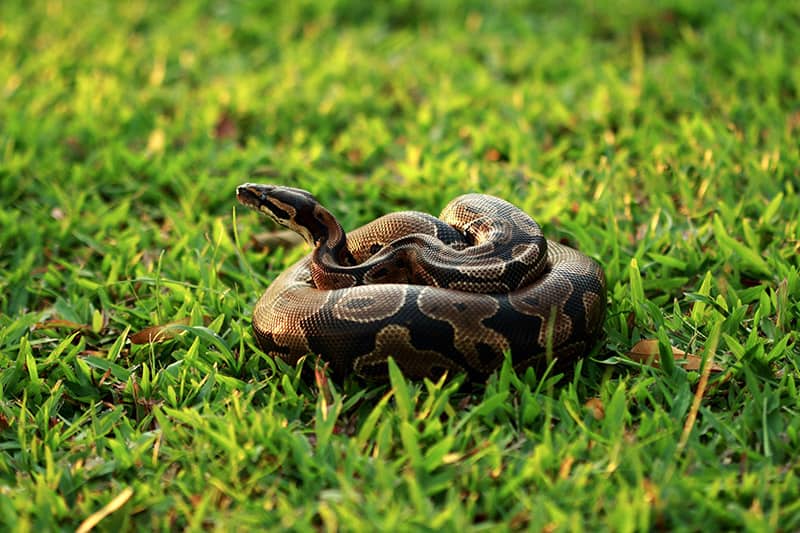
Scientific Name
Habitat: Distribution/Background
The Ball Python or Royal Python Python regius was described by Shaw in 1802. The Ball Python is native to Africa with a wide distribution from Sudan and Uganda in central Africa, and throughout western Africa to Senegal. Tongo, Benin, and Ghana are where the majority of the imported ball pythons are from. They inhabit dry areas, living in both grasslands and open forests, and are also found in agricultural areas.
Status
The Python regius is on the IUCN Red List for Endangered Species as Least Concern (LC). The Ball Python has an extensive range. It is harvested by natives for food and leather, and collected for the pet trade, so it is suspected of having a declining population, but it is not large enough to warrant a threatened status.
Description
The Ball Python is the smallest of the African python species. They will grow to between three and five feet (.91 to 1.27 m) with females generally larger than males. Hatchlings usually emerge at 8 to 12″ (20 – 51 cm). They have a robust body with a short tail.
Being a wide bodied snake, they use rectilinear movement to crawl forward in a perfectly straight line. This is where they press sections of their body into the ground and then use their muscles to propel them forward. They will typically live 20 to 30 years in captivity or longer. One female specimen at the St. Louis Zoo was estimated to have lived more than 55 years.
Their natural coloring is a dark brown background, broken with irregular cream colored or yellowish buff patches. Juveniles will often be brighter and more yellow in coloration than adults. Many unusual color and pattern variations occur naturally with this snake, creating a variety of Ball Python morphs, especially as juveniles. However, these colorations are inspiring the breeding efforts of enthusiasts to develop these color morphs.
Ball Python morphs colors and patterns:
Yellow – Yellow Orange
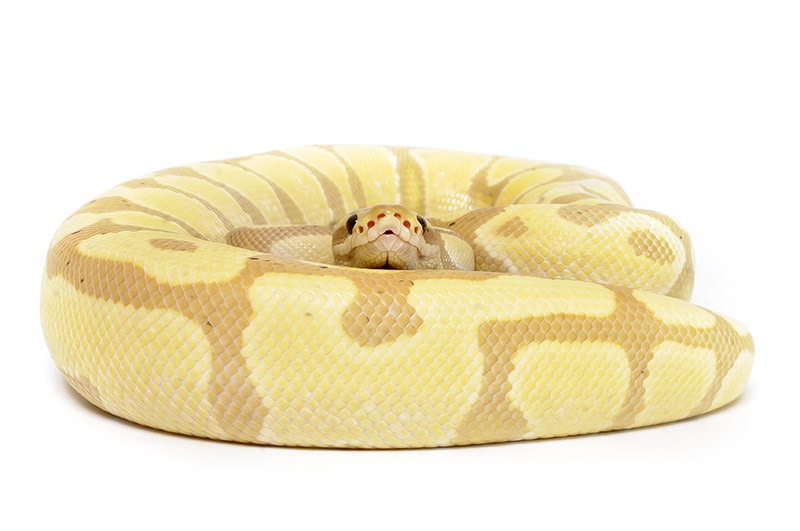
Some specimens have a distinct shade of orange or coral along the lower margins of sides, though it often becomes brown as they mature.
High Gold
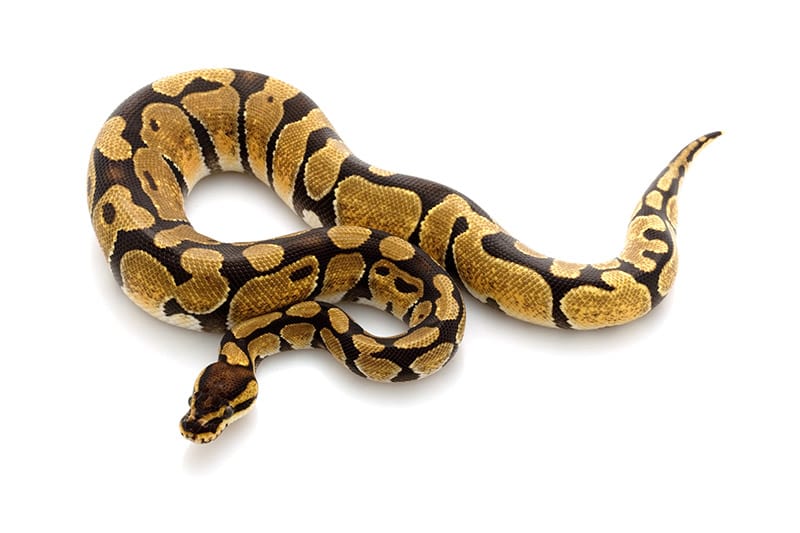
Some specimens have an extreme amount of yellow or gold coloring as juveniles, often with black patches that accentuate the gold. On some individuals there can also be some patches of faded color, giving the snake a yellow appearance with black banding. The yellows generally become brown as they mature.
Jungle
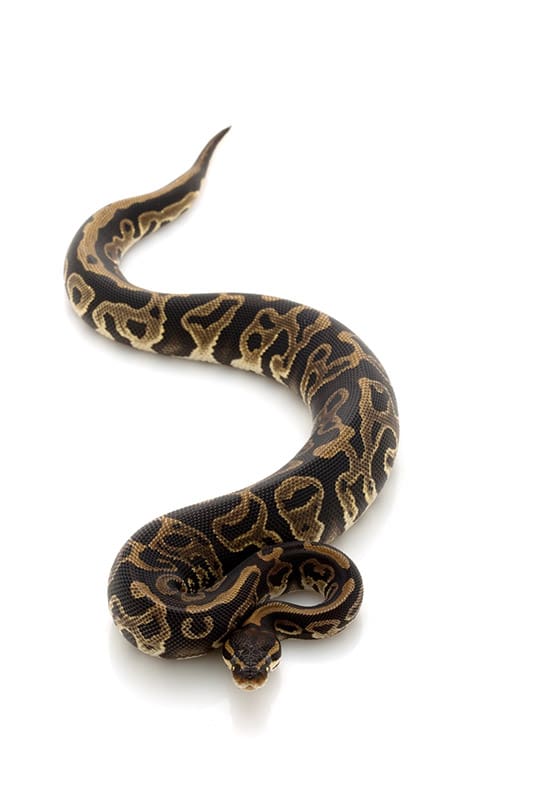
This is an extremely beautiful, and highly sought, color pattern. Juveniles have yellow eyes, a pale brown spot on top of the head, and an patches in an irregular black pattern. As adults they become brown with irregular black markings, and they have pale eyes.
Black or Melanistic
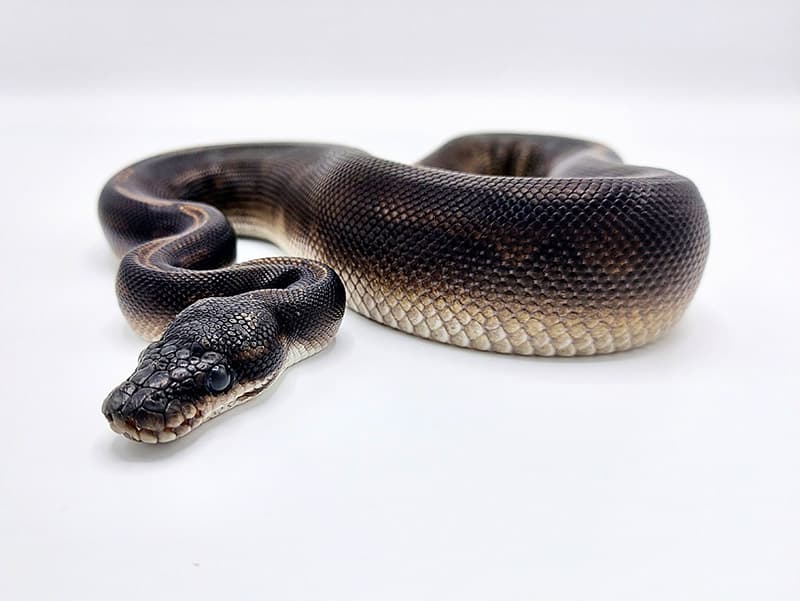
These individuals have dark pigments suffused in the dark patches, both as juveniles and adults.
Axanthic

These individuals lack the yellow pigments, and are seen in two forms. The typical form is a pale gray with black markings, both as juveniles and adults. The other form has an ivory white with black markings, though as they mature they become increasingly dark and the patterns become a charcoal gray, making the pattern almost hardly visible.
Xanthic

This is the reverse of the axanthic condition, making individuals who are a beautiful yellow or gold both as juveniles and adults.
Albino
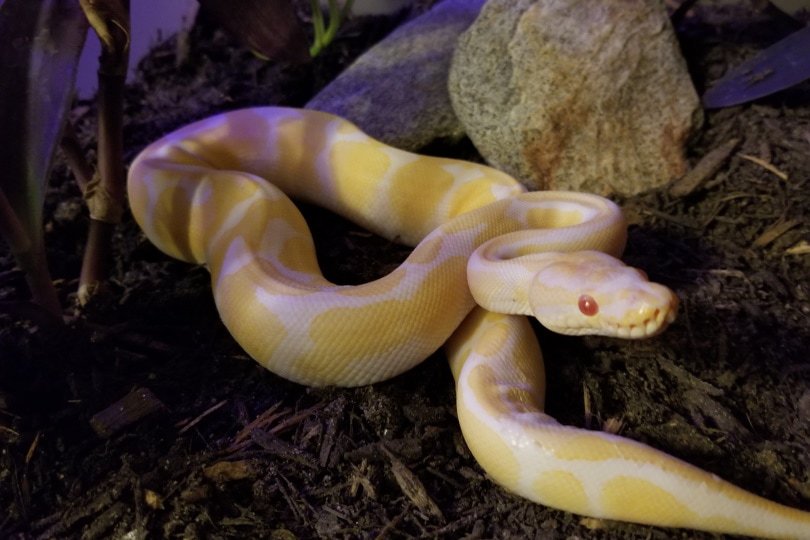
Albino is the absence of black pigment. These snakes are white with a yellow patterning and pink or orangish pink eyes. The Albino Ball Python is one of the most exiting and popular morphs being bred.
Leucistic

This is an absolute white coloration with no patterning, and dark eyes. It is extremely rare.
Piebald
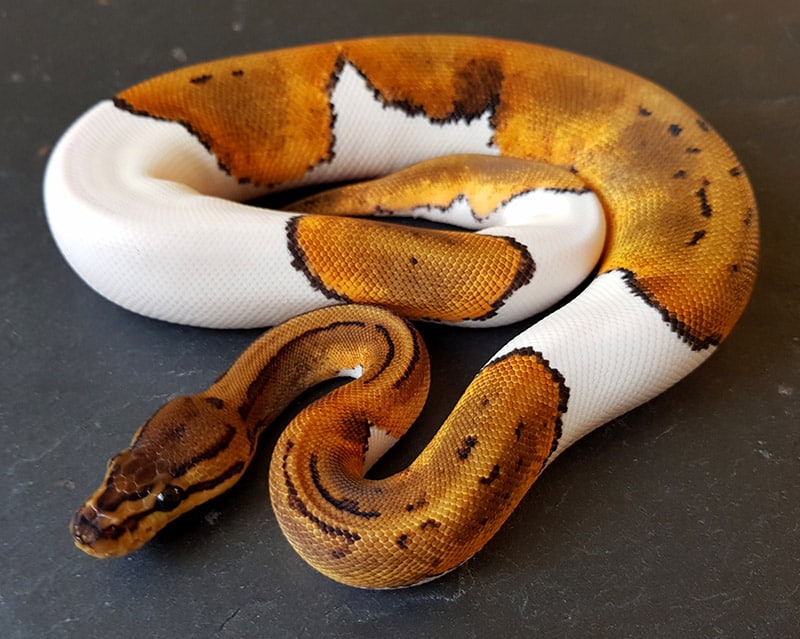
These are very interesting and beautiful snakes. This is where the head and along the back are normal, but there are large areas of the body that are white and patternless. Areas along the back can be interspersed with the white patternless patches.
Banded or Cross-over
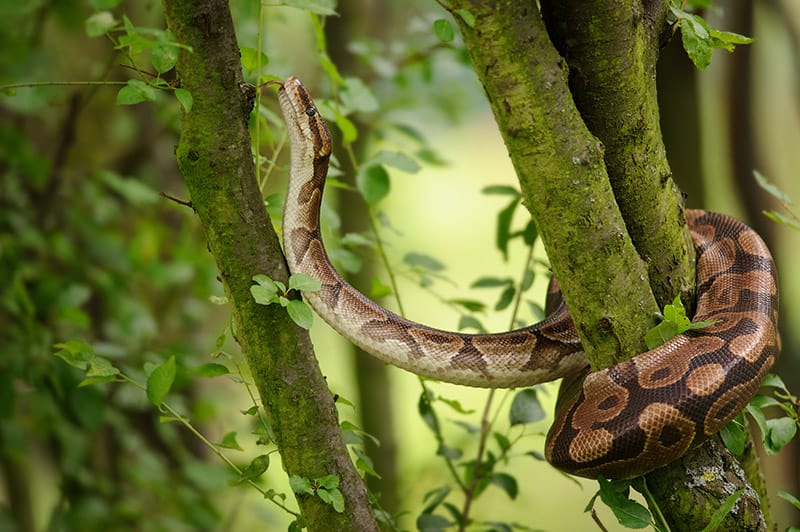
These individuals have the patches on the sides joining on the back, giving an appearance of an irregular shaped bands on the snake.
Striped

Similar to the banded, this is where the blotches join in an elongate fashion, and is said to simply appear randomly. Those that have very broad stripes, usually 7 to 12 scale rows wide, are known as the Wide-Striped Ball Python. Another variation, called the Black-backed Ball Python, is missing the pale vertebral blotches.
Clown

The clown is an extreme version of the Black-backed Ball Python. It is characterized by little patterning on the sides, dark lines on the head, and a dark “tear” spot under one of the eyes, giving it the “clown” appearance.
Ghost

These individuals are an extremely rare occurrence. They have very small rounded dorsal scales, which give it an iridescent appearance. Its patterning is normal but the colors are soft and muted.
Food and Feeding
They are a constrictor and their diet consists of small rodents. They will eat mice and rats throughout their lives. They are nocturnal, so feed at night. Small Ball Pythons will feed on small “fuzzy” mice (once a week) and will begin to consume larger mice and even small rats as they grow. Adults will feed on adult mice or small rats (one or two every week to ten days).
Ball Pythons will often refuse food if they are handled excessively or when their habitat changes. They will need time to get comfortable in new surroundings.
Fresh water in a good size water dish should always be available. A shallow water dish works well. The python will usually climb in and may get water on the substrate. If this happens, the substrate should be changed or alternatively, the python can be soaked in a separate water dish once a week.
Housing
The Ball Python or Royal Python is a terrestrial snake that inhabits both open forests and grasslands, It can be housed in a woodland type terrarium with adequate humidity. See terrarium set-ups described under Basic Reptile and Amphibian Care for more information on woodland terrariums.
Adult Ball Pythons require a terrarium that is roughly 36″ long x 18″ wide (91 x 46 cm), or 24″ long x 12″ wide (60 x 30 cm) for a younger python. Hatchling Ball Pythons will thrive in a smaller enclosure approximately 10″ wide and 12″ long (25 x 30 cm), roughly the size of a ten-gallon terrarium.
Young Ball Pythons can be kept on a substrate of paper towel. It is easy to clean, inexpensive, and allows you to closely monitor the enclosure for cleanliness and fecal material. For a more naturalistic setup, you can use cypress mulch and aspen bedding. We do not recommend using newspaper as it is messy and ugly.
A good-sized water dish will provide a place for soaking and drinking. A heavy limb with plant vining is good for climbing on. One cage accessory that is a must for a Ball Python is the hide box. These are secretive snakes that will spend a great deal of their time hiding. The snake should be allowed to wedge itself tightly into the shelter so it will feel secure. Commercial plastic shelters, clay flowerpots, and a variety of other shelters can be used.
Temperature and Lighting requirements
The Ball Python enclosure should always be large enough to provide the Ball Python with a warm side and a cool side. This can be accomplished best by placing a small heating pad under one corner of the enclosure. The ideal temperature range is 80° to 85 °F during the day and a warmer area that remains in the 88° to 90° F range. They can easily tolerate a drop at night to 75° to 78 °F.
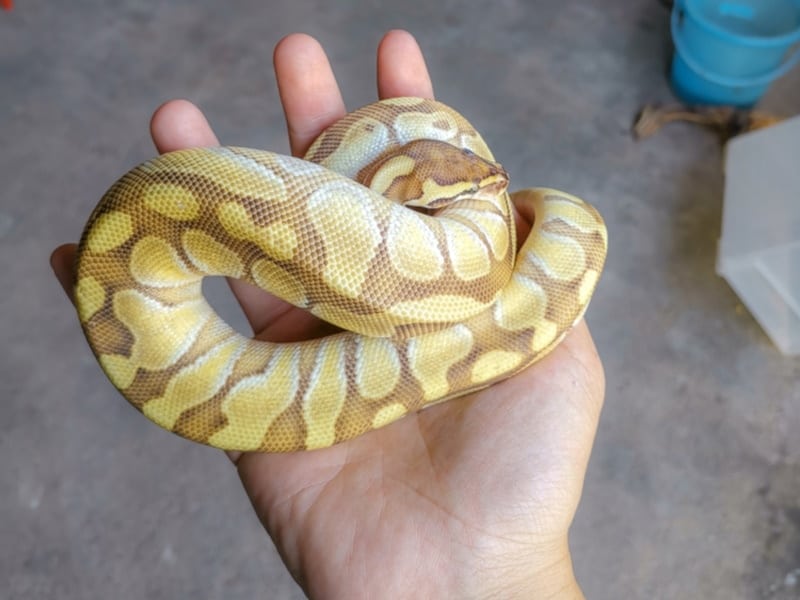
Cage Care
Cage maintenance is an important part of keeping reptiles healthy, and long-lived. Reptiles being kept in a confined area as pets need to be protected from harmful micro-organisms and parasites. The reptile cage needs daily and weekly maintenance. Provide fresh food and water in clean dishes everyday. Check on a daily basis to make sure that the tank is clean. As with any reptile, feces should be removed as soon as they are discovered.
Everything you put into their home should be washed and disinfected weekly. This includes dishes and cage decor. All of the substrate should be changed every three to four months. Never clean with a phenol such as Pine Sol. Chlorine and alcohol based cleaners are tolerated much better, but need to be thoroughly rinsed.
Social Behavior
By nature, Ball Pythons are secretive and spend most of their days hiding in tight-fitting shelters. They are nocturnal so are more active at night. These snakes can be housed alone or in groups with other snakes of similar size and habits.
Handling
Ball Pythons can become very tame, however as small babies, they are quite secretive and nervous. They will spend most of their time coiled in a tight ball or hiding in their shelters. As they grow (and are held more often by the keeper) they become less timid and will actually begin to explore their enclosure and climb about on the keeper’s hands. (Be careful as they can disappear quite quickly when you run to the kitchen for a drink or take a phone call.)
The Ball Pythons temperament and willingness to be handled makes them an easier snake for children to handle. But children should always be supervise when they are handling them. As with all reptile pets, anyone who handles the reptile should be sure to wash his or her hands after handling their pets.
Reproduction
These snakes, if not babies, need to be probe sexed for positive sex identification. They are typically sexually mature between 2 and 3 1/2 years though occasionally a ball python will be mature at about 18 months.
A healthy pair of Ball Pythons will usually show interest in breeding at two years of age. (Males usually sooner and females occasionally longer, depending on the feeding schedule.) A sexually mature male is typically a 30 to 36″ (76 – 91 cm) animal, while a female will need to be in the 40″ (102 cm) and 1000 gram+ range. Typically the female is introduced into the male’s enclosure after each snake has been fed well.
They have small clutches, in the 4 to 8 egg range. They will breed in the cool, rainy seasons. In nature, after laying the female then broods the eggs. You can let the female incubate the eggs herself (in a nest box) or you can remove the eggs to be incubated in an incubator. If they are removed, the eggs should be incubated in a mixture of damp vermiculite.
The eggs will hatch in 50 to 60 days at an incubation temperature of 82° to 86° F (28 – 30° C). The hatchlings range from 10″ (25.4 cm) to 17″ (43.2 cm) in length.
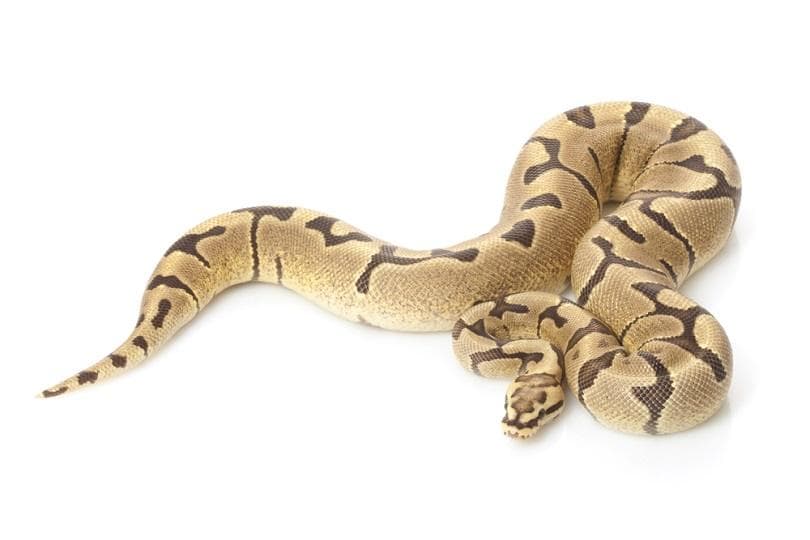
Diseases: Ailments/Treatments
As most Ball Pythons available to keepers are captive-hatched babies, there are relatively few health concerns as long as they are kept in a proper enclosure and are fed the proper diet. Many Ball Pythons are farm-raised in Africa and arrive by the thousands each year. These should be watched closely in the early days as they can have feeding issues and occasionally arrive with other problems.
Some illness to be aware of are:
Mites and ticks
These small ectoparasites are occasionally seen on pet snakes. They typically arrive with imported pythons or are infested when they are housed at a reptile dealer’s facilities. They should be removed as they feed on blood from the host (your python) and can cause stress and can carry diseases. There are a wide range of products available to keepers for the removal of these parasites.
Respiratory illnesses
Pythons that are kept too cool can get respiratory issues that can be life-threatening. Signs of problems include frequent yawning, gaping, gasping or opening of the mouth, and bubbling from the nose. Seek veterinary help if you see a combination of any of these signs. (A snake will yawn to realign its jaws after feeding. This is a normal behavior.)
Dermal Fungal Infections
If a Ball Python is kept too cool or too humid for an extended period of time, the snake may develop skin lesions that will become crusty and bloody. A keeper should immediately look at his or her enclosure and make sure that the snake is being kept warm and dry enough. Clean the lesions with a gentle wash of Betadine or antibiotic cream until it heals.
“Mouth Rot”
If a snake’s mouth does not shut well or if you see unhealthy exposed gum tissue, this may be a sign of infective stomatitis or “mouth rot”. Healthy gums are a light pinkish white without marks or red veining. Red splotches or other discolored areas may be early signs of “mouth rot”.
Shedding Problems
Stuck sheds, retained eye caps, and other shedding problems are occasionally seen in Ball Pythons. Though the area in which they live is relatively hot and dry, they do spend a great deal of time in burrows, underground, and even in termite nests. These areas are not only warm, but are also humid. So, when a Ball Python is ready to shed (first signs are opacity of the eyes), the humidity within the enclosure or especially under the shelter should be raised. This will allow for proper shedding.
Rodent Bites
Never leave a live feeder rodent in a snake’s enclosure. A freaked-out mouse or rat may attack the snake. Though they are great predators, many captive Ball Pythons are attacked by live rodents each year and many of them die horrible deaths. Either remove the rodent if it is not eaten right away or feed your snake pre-killed prey.
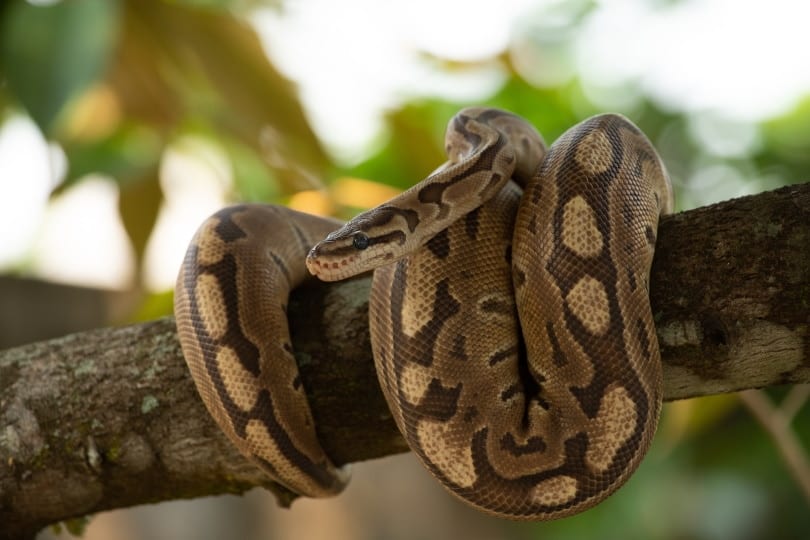
Availability
The Ball Python is one of the most widely available snakes in the pet industry. They can be purchased as either a wild-caught or a captive-bred snake. Though the captive-bred Ball Python may cost a bit more, it is generally more docile initially and more inclined to eat.
Many Ball Pythons available each year are farm-raised in Africa and exported to the U.S. pet trade. These animals are generally healthy and feeding well, but some may have minor problems such as skin sores or lack of appetite. There are also thousands of captive-hatched Ball Pythons available each year and many more to be produced in the future.
For a great pet, find a snake that is normally patterned ($25 to $40 each) and feeding well. You will find these snakes at a better reptile or pet stores, on-line, or at a reptile show or expo. It is always cheaper and less stressful on the animal if you can hand-pick it and you have the opportunity to look it over for good weight, clean mouth, good eyes, and general healthy appearance.
Featured Image Credit: fajar_achmadi, Shutterstock
